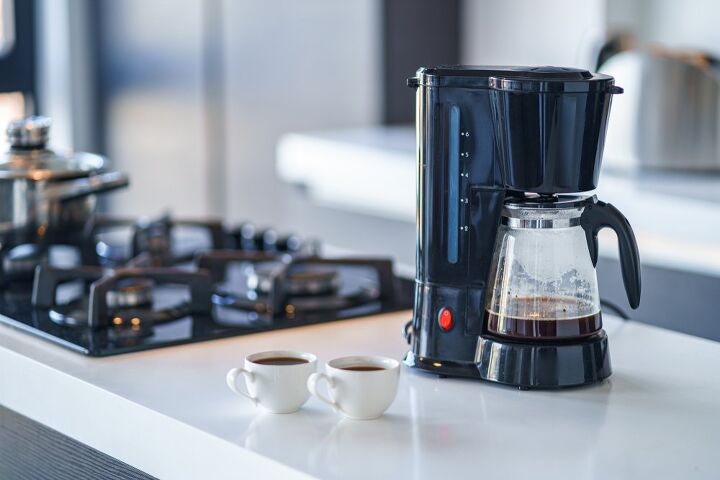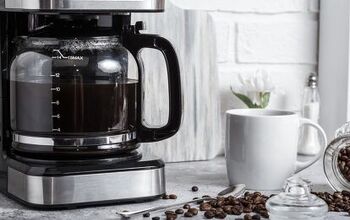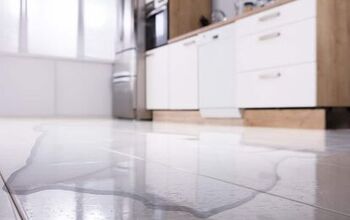Bunn Coffee Maker Leaking? (Possible Causes & Fixes)

If you love to drink coffee, having a coffee maker just makes things easier. Bunn is one of the most recognizable names for coffee makers around, giving coffee lovers access to a quick cup of Joe whenever they want.
From time to time, however, it can spring a leak. You may notice water pooling at the base of the coffee maker, leading you to wonder what the issue is. There are a few reasons why this is happening. It could be as simple as normal wear and tear, the accumulation of minerals from hard water, or even gaskets and seals that have deteriorated.
Why is My Bunn Coffee Maker Leaking?
More often than not, your coffee maker will begin leaking because it needs cleaning, maintenance, or both. The four most common reasons for a Bunn coffee maker leaking are:
- Normal wear and tear. Things break down over time, especially with frequent usage. Make sure that you properly maintain your coffee maker to give it an extended life. If your Bunn coffee maker is getting up there in age, it may simply be time to replace it altogether.
- Lack of care or maintenance. All appliances need proper care. That care and maintenance is meant to nip problems in the bud and ensure that your coffee maker is working optimally. Ignoring proper maintenance will likely lead to leaks and shorten the life of the coffee maker substantially.
- Bad gaskets or seals. Similar to any other appliance, there are gaskets and seals within the coffee maker. Those components prevent water from leaking out during use. Overtime or due to excessive use, they can wear out over time. It could be as simple as replacing these components.
- Mineral deposits. Depending on where you live, the water can be harder than normal. That means more minerals in the water than would be in other areas. Hard water can accumulate in your coffee maker, coating it with those minerals. Cleaning out the coffee maker can be the simplest fix in this case.
Properly Cleaning Your Bunn Coffee Maker
One of the best ways to extend the life of your coffee maker is to clean it thoroughly from time to time. That doesn’t mean simply washing it with a sponge and some water. You have to get into the tough spots to clean out grime and the aforementioned mineral deposits.
Those mineral deposits can be taken care of with household items like vinegar. Run the vinegar through a normal coffee cycle to provide a thorough cleaning for your Bunn coffee maker. It should resolve any buildup issues that you are experiencing.
The Grounds Basket Overflows
There may also be an issue where the grounds basket or the filter of your Bunn coffee maker becomes an issue. This is also a fairly common occurrence and can typically be resolved with a fairly simple resolution.
It is important to recognize the reasons why the basket is overflowing. You can then take preventative measures to ensure that it doesn’t overflow again.
Smaller Outlet
The first and most likely reason that the grounds basket is overflowing is that the outlet is noticeably smaller than the inlet. When that happens, water will flow out of the filter at a faster rate than it is coming in. Overflowing is then the result.
When the water gets out from underneath the basket, more water will then accumulate in it. When it hits that threshold, it has no choice but to flow over the side of the basket.
The fix. Fixing this is easy in that you have to restrict and regulate water flow. If you want to, you can also buy a new, higher-quality filter specifically for the Bunn coffee maker.
Lower Quality Coffee
Believe it or not, the quality of the coffee that you use can play a role in the longevity of your coffee maker. By going cheaper on your coffee, the consistency can lead to blockages in other components of the coffee maker.
When there are blockages, the grounds basket will begin to overflow. Buying better quality coffee, one with grounds that don’t easily clog in the filter, can save you quite a bit of trouble with overflow and cleanup.
Why is it Important to Adjust Water Flow in a Bunn Coffee Maker?
The water flow in any coffee maker, not just a Bunn, has to be properly adjusted. If it isn’t, things can get out of control quickly and leave you with a big mess. Water can seep everywhere before you know it and cause water damage if the problem isn’t noticed immediately.
Adjusting water flow is also important for safety reasons. When using the coffee maker, the water will get to be boiling hot. If it overflows, you run the risk of burning yourself in the process. That is just another thing that can go wrong without adjusting water flow.
How Do You Adjust Water Flow in a Bunn Coffee Maker?
Thankfully, adjusting and regulating the water flow is a relatively easy venture. Just follow these steps:
- Check the spray head. Start by checking the spray head in the coffee maker. If it is undamaged, then it should provide proper water flow. Unfortunately, the spray heads in most coffee machines are quite fragile and damage easily. If the head is damaged, water flow will be difficult to regulate, spilling and overflowing everywhere. Replace the spray head if it is damaged.
- Replace old filters. The type of filters that you use can also play a role in water flow. The wrong kind and you could be dealing with spills more often than not. Try using a higher-quality filter instead of something cheap. Better quality means better flow regulation which means less spillage cleanup.
- Clean excess grounds. It is only normal, especially when dealing with liquids and coffee grounds, to make a little bit of a mess within the coffee maker. Try removing any excess grounds that you see leftover after a brew. It will help reduce the need for major cleanups later.
How Much Coffee and Water to Put in a Bunn Coffee Maker
Another thing that you can do to prevent overflow and spillage is to put in the right amount of water and coffee to begin with. Not only that, but it will help you to create the perfect coffee brew that is both refreshing and delicious.
Moreover, the right amounts will reduce other problems that you may face with your coffee maker. Thankfully, there are helpful hints for brewing the right sized pot of coffee.
- Fill the pot with water. Start by filling the coffee pot with anywhere between 4 and 10 cups of water, pouring into the machine.
- Let it warm. When you have filled the coffee machine with water, turn on the machine, and let it warm up for a few minutes before moving on to the next step.
- Adding the coffee. If you are looking for a milder brew, add in 2 tablespoons of coffee. For something more potent, make it 3 tablespoons.
It is as simple as that. Keeping the amounts correct will put less stress on the coffee maker and provide you with the perfect pot of coffee.
How Do You Drain a Bunn Coffee Maker?
Maintenance is essential for extending the life of your coffee maker. That means properly draining and cleaning it. Thankfully, the process of draining is a bit simpler with a little help.
- Open the lid. Start by opening the lid on top. Try to handle with care as some of the components of your coffee maker can be a little more susceptible to damage.
- Locate the valve arm. On the inside of the coffee maker, you should see a valve arm. When you have located it, remove the arm and flip over the machine.
- Flipping the machine. By flipping over the coffee maker, you will drain out all of the contents within. Give it a couple of minutes; some of the tougher remnants may take a bit.
- Clean everything thoroughly. Make sure that you give every one of the components as well as the interior a good wipe.
- Dry. Finally, let the machine dry for a half-hour before you use it again otherwise there might be a weird taste leftover.

Ryan Womeldorf has more than a decade of experience writing. He loves to blog about construction, plumbing, and other home topics. Ryan also loves hockey and a lifelong Buffalo sports fan.
More by Ryan Womeldorf



























